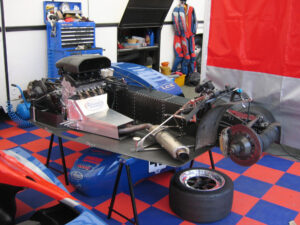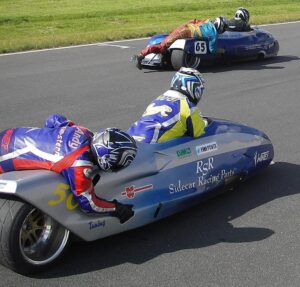 As long as there have been vehicles, there have been people who felt the need to race them. Enter Sidecar Racing. Like all forms of racing, Sidecar Racing began with started with vehicles built for the street. They were a simple motorcycle with a simple sidecar attachment. Over the years, however, the sidecars have evolved to increase speed and safety.
As long as there have been vehicles, there have been people who felt the need to race them. Enter Sidecar Racing. Like all forms of racing, Sidecar Racing began with started with vehicles built for the street. They were a simple motorcycle with a simple sidecar attachment. Over the years, however, the sidecars have evolved to increase speed and safety.
`
The early modifications were to lower the center of gravity by laying the driver forward over the engine. This modification reminds me of the Ninja motorcycle, otherwise known as the crotch rocket. It inspires speed in the vehicle. The sidecar itself was also changed from a mere basket to a platform, so that the passenger or monkey, could be mobile. Having a mobile passenger meant a moveable mass to help keep the tires on the ground at higher speeds. The passenger could lean this way and that to help stabilize the motorcycle and sidecar. As with any vehicle, the basic motorcycle components were used to build the racer…engine, steering, and larger diameter treaded tires. The racer was void of anything that could get in the way of aerodynamics. All that was there were fenders and whatever the driver and passenger could provide. Oddly, this type of sidecar, original around 1949, is still raced today in vintage classes, and most are home built.
Nevertheless, the vintage class has given way to the modern class, and after years of modifications and updates and the modern sidecar has emerged. Even today, some of the modern sidecars are home-built, but there are also companies who are dedicated to building sidecars. Whereas the home-built sidecars tend to be  made of steel tubing and are less refined, the specialized companies use aluminum, carbon fiber, or other types of stronger, lighter material, designed to make the vehicle even faster. These specialized shops are also able to build a vehicle with a better suspension and better handling, as well as single swing arms for ease of wheel change. The modern sidecars use slick tires, as opposed to the larger diameter treaded tires. Race cars made the slick tires “famous” for their ability to build speed before takeoff. They also have molded aerodynamic bodies, probably much better than the home-built models, at least as far as speed is concerned.
made of steel tubing and are less refined, the specialized companies use aluminum, carbon fiber, or other types of stronger, lighter material, designed to make the vehicle even faster. These specialized shops are also able to build a vehicle with a better suspension and better handling, as well as single swing arms for ease of wheel change. The modern sidecars use slick tires, as opposed to the larger diameter treaded tires. Race cars made the slick tires “famous” for their ability to build speed before takeoff. They also have molded aerodynamic bodies, probably much better than the home-built models, at least as far as speed is concerned.
These days, there are three types of modern sidecars. Known as F1 (Formula 1), F2 (Formula 2), and F3 (Formula 3), with the F2 and F3 sidecars having the motors positioned under the drivers. Oddly, for full out speed, the best choice is the F1 model sidecar. I guess that placing the driver on top of the engine wasn’t the best modification for speed. The F1 models are sometimes referred to as long bikes. The motor on the F1 is behind the driver. The maximum engine displacement in this category is 1000cc 4 stroke. For the F2, the maximum engine displacement is 600cc 4 stroke or 500 cc 2 stroke. Engines are pre-1996 for F3. The F2 and F3 sidecars have a shorter wheelbase than the F1. This gives them better handling on short tracks, so  apparently the racer needs to know what model will fill the need for the track being raced. Whichever class the racer choses, the sidecar wheel will not have any suspension. The engines can be carbureted, or fuel injected. One hard and fast rule is that they must also be chain or belt drive, because shaft drive engines are allowed. Other than these many changes, the basic design is the same as the vintage sidecar racers. Obviously, if the sidecar were placed anywhere else, it would not be a sidecar. The sidecar racers usually run between $6,000 to $20,000 and will last for several years…probably a bargain considering the amount of money that goes into most race vehicles.
apparently the racer needs to know what model will fill the need for the track being raced. Whichever class the racer choses, the sidecar wheel will not have any suspension. The engines can be carbureted, or fuel injected. One hard and fast rule is that they must also be chain or belt drive, because shaft drive engines are allowed. Other than these many changes, the basic design is the same as the vintage sidecar racers. Obviously, if the sidecar were placed anywhere else, it would not be a sidecar. The sidecar racers usually run between $6,000 to $20,000 and will last for several years…probably a bargain considering the amount of money that goes into most race vehicles.
FIM (International Motorcycling Federation) Sidecar World Championship is the international sidecar racing championship. It is the only remaining original FIM road racing championship class that started in 1949.


Leave a Reply